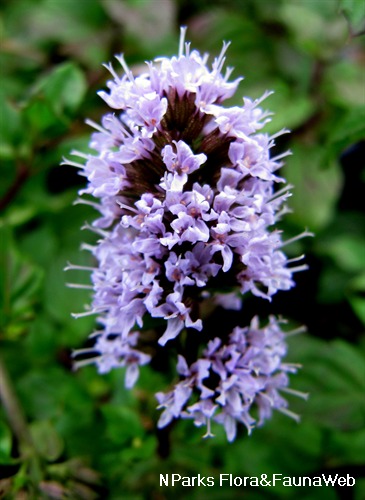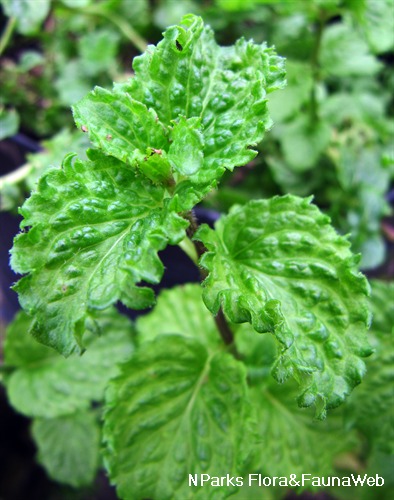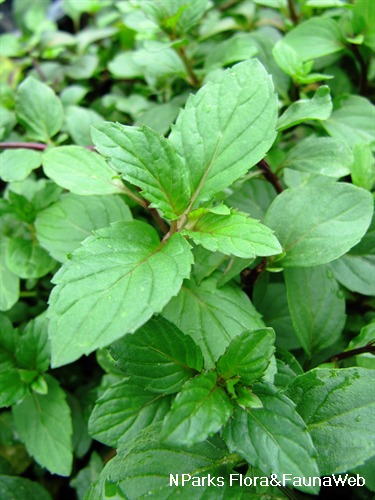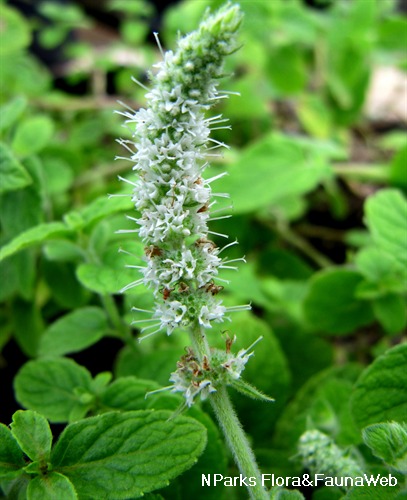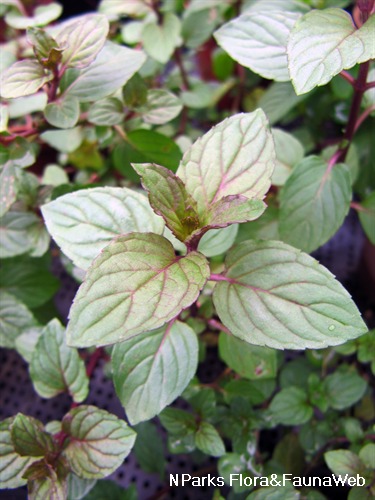
Back
Mentha × smithiana
| Family Name: | Lamiaceae (Labiatae) |
| Synonyms: | Mentha × rubra, Mentha arvensis var. rubra, Mentha aquatica var. rubra |
| Common Name: | Red Mint, Smith's Mint |
Name
Classifications and Characteristics
| Plant Division | Angiosperms (Flowering Seed Plants) (Dicotyledon) |
|---|---|
| Plant Growth Form | Shrub |
| Lifespan (in Singapore) | Perennial |
| Mode of Nutrition | Autotrophic |
| Maximum Height | 45 cm |
Biogeography
| Native Distribution | Europe |
|---|
Description and Ethnobotany
| Growth Form | Herbaceous perennial up to 45 cm tall. |
|---|---|
| Foliage | Leaves are green with reddish tints. They are oval to egg-shaped with toothed leaf margin. |
| Stems | Stems are square in cross-section and green with reddish tints. |
| Flowers | Light purple flowers are tubular and 2-lipped. They are arranged in a spike inflorescence. |
| Fruit | Tiny, one-seeded fruits are known as nutlets. |
| Habitat | This natural hybrid is common throughout central Europe. It is less common in the wild, but often found in areas where garden waste is collected. |
| Taxonomy | It is a natural hybrid of Mentha spicata and M. x verticillata (a hybrid of M. aquatica and M. arvensis). It is typically sterile. |
| Cultivation | Although this hybrid tolerates partial shade, leaves will be more flavorful when grown under full sun in moist, but well-drained soil (pH 6-7). |
| Ethnobotanical Uses | Edible Plant Parts : Edible Leaves Food (Herb or Spice): The leaves are used as a culinary herb, such as in sauces and salads. It is used to make mint sauce for meat dishes, like roasted lamb. |
Landscaping Features
| Desirable Plant Features | Fragrant (Foliage) |
|---|---|
| Landscape Uses | Interiorscape/ Indoor Plant, Container Planting |
| Thematic Landscaping | Economic Garden |
| Usage Hazard - Cons | Invasive / Potentially Invasive |
Plant Care and Propagation
| Light Preference | Full Sun |
|---|---|
| Water Preference | Moderate Water |
| Rootzone Tolerance | Moist Soils, Well-Drained Soils |
| Propagation Method | Stem Cutting |
Foliar
| Mature Foliage Colour(s) | Green |
|---|---|
| Foliar Type | Simple / Unifoliate |
| Foliar Arrangement Along Stem | Opposite |
| Foliar Attachment to Stem | Petiolate |
| Foliar Shape(s) | Non-Palm Foliage (Oval) |
| Foliar Venation | Pinnate / Net |
| Foliar Margin | Serrate / Toothed |
| Foliar Apex - Tip | Acute |
| Foliar Base | Rounded / Obtuse |
| Mature Foliage Colour(s) Remarks | Green leaves with reddish tints |
Floral (Angiosperm)
| Flower & Plant Sexuality | Bisexual Flowers |
| Flower Colour(s) | Purple |
|---|---|
| Flower Grouping | Cluster / Inflorescence |
| Flower Location | Terminal |
| Flower Symmetry | Bilateral |
| Individual Flower Shape | Tubular |
| Inflorescence Type | Spike |
| Flowering Habit | Polycarpic |
Image Repository
Others
| Master ID | 31120 |
|---|---|
| Species ID | 5511 |
| Flora Disclaimer | The information in this website has been compiled from reliable sources, such as reference works on medicinal plants. It is not a substitute for medical advice or treatment and NParks does not purport to provide any medical advice. Readers should always consult his/her physician before using or consuming a plant for medicinal purposes. |

